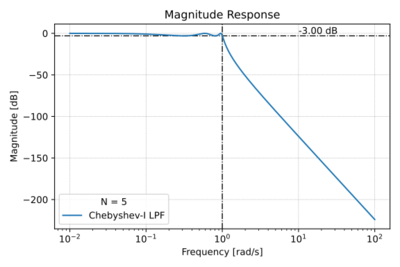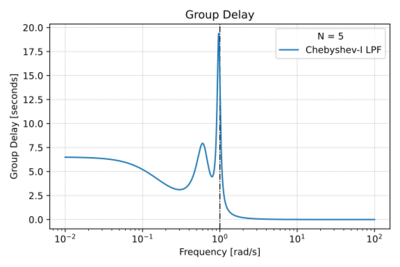Chebyshev filters come in two flavors: the Type-I and Type-II.
The Chebyshev Type-I Low-Pass Filter
Chebyshev Type-I filters are also all-pole filters, with poles of the normalized ( ) filter located on an ellipse inside the unit circle, as shown in Fig. 1. This arrangement of poles results in (1) a shorter transition band, and therefore a steeper roll-off compared to the Butterworth low-pass filter of the same order, shown in Fig. 2, (2) poorer group delay characteristics as depicted in Figs. 3 and 4, and (3) ripples in the pass-band also seen in Fig. 2. By allowing larger ripples in the pass-band, we get: (1) a narrower transition band, and hence sharper cut-off, (2) higher Q poles, and (3) more degradation in the phase response.
) filter located on an ellipse inside the unit circle, as shown in Fig. 1. This arrangement of poles results in (1) a shorter transition band, and therefore a steeper roll-off compared to the Butterworth low-pass filter of the same order, shown in Fig. 2, (2) poorer group delay characteristics as depicted in Figs. 3 and 4, and (3) ripples in the pass-band also seen in Fig. 2. By allowing larger ripples in the pass-band, we get: (1) a narrower transition band, and hence sharper cut-off, (2) higher Q poles, and (3) more degradation in the phase response.
 Figure 1: The Chebyshev Type-I pole-zero with  and a  ripple. |
 Figure 2: The Chebyshev Type-I low-pass filter magnitude response with  and a  ripple. |
 Figure 3: The Chebyshev Type-I low-pass filter phase response with  and a  ripple. |
 Figure 4: The Chebyshev Type-I low-pass filter group delay with  and a  ripple. |
The Chebyshev Type-I magnitude response is given by:
-
 |
|
(1)
|
Where  is the cut-off frequency,
is the cut-off frequency,  is the ripple factor with ripple
is the ripple factor with ripple  in dB, and
in dB, and  are solutions to the Chebyshev differential equation:
are solutions to the Chebyshev differential equation:
-
 |
|
(2)
|
For a normalized filter, or  , the poles of the Chebyshev Type-I low-pass filter are the roots of
, the poles of the Chebyshev Type-I low-pass filter are the roots of  . In practice, instead of solving this equation directly, we can easily get the roots (and hence the poles) of the filter magnitude response using tools such as Python or Matlab.
. In practice, instead of solving this equation directly, we can easily get the roots (and hence the poles) of the filter magnitude response using tools such as Python or Matlab.
The Chebyshev Type-II Low-Pass Filter













